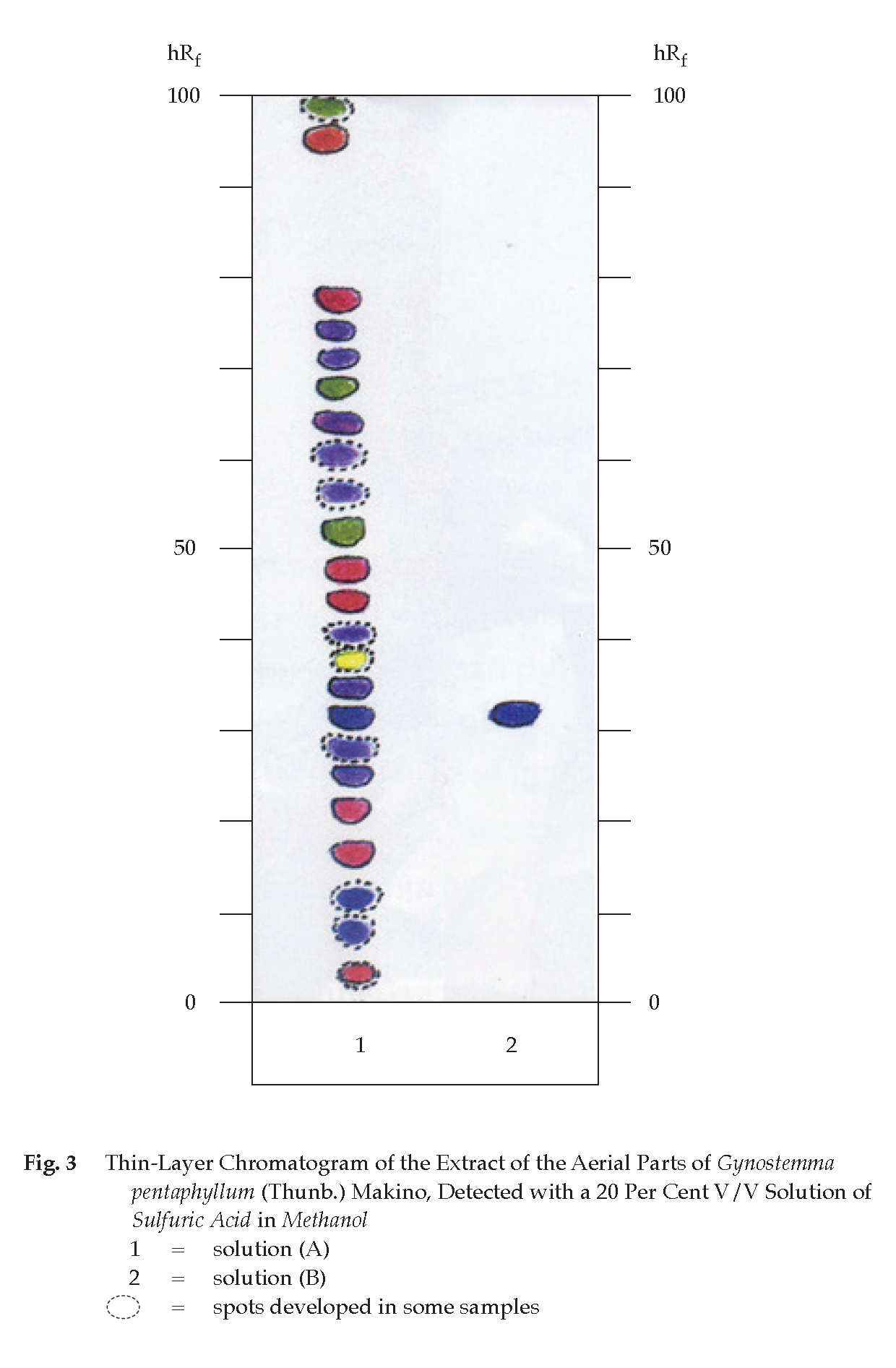ตำรามาตรฐานยาสมุนไพรไทย
Thai Herbal Pharmacopoeia
สำนักยาและวัตถุเสพติด กรมวิทยาศาสตร์การแพทย์ กระทรวงสาธารณสุข
Bureau of Drug and Narcotic, Department of Medical Sciences, Ministry of Public Health(Tinospora crispa (L.) Hook.f. & Thomson)
(Nelumbo nucifera Gaertn.)
(Centella asiatica (L.) Urb.)
(Centella Dry Extract)
(Centella Cream)
(Mesua ferrea L.)
(Piper sarmentosum Roxb.)
(Piper sarmentosum Roxb.)
(Pterocarpus santalinus L. f.)
(Santalum album L.)
(Senna tora (L.) Roxb.)
(Senna alata (L.) Roxb.)
(Senna Alata Tea)
(Piper retrofractum Vahl)
(Myristica fragrans Houtt)
(Andrographis paniculata (Burm. f.) Nees)
(Andrographis Capsules)
(Allium ascalonicum L.)
(Ocimum tenuiflorum L.)
(Curcuma longa L.)
(Turmeric Capsules)
(Turmeric Dry Extract)
(Turmeric Dry Extract Capsules)
(Arcangelisia flava (L.) Merr.)
(Curcuma sp.)
Harrisonia perforata (Blanco) Merr.
(Aristolochia pierrei Lecomte)
(Zingiber officinale Roscoe)
(Ginger Capsules)
(Ginger Tea)
(Cassia fistula L.)
(Nardostachys jatamansi (D. Don) DC.)
(Angelica sinensis (Oliv.) Diels)
Artemisia annua L.
(Ligusticum sinense Oliv. cv. Chuanxiong)
(Neopicrorhiza scrophulariiflora Pennell)
(Atractylodes lancea (Thunb.) DC.)
(Aucklandia lappa Decne)
(Terminalia chebula Retz.)
(Angelica dahurica (Hoffm.) Benth. & Hook. f. ex Franch. & Sav. var. dahurica)
(Kaempferia parviflora Wall. ex Baker)
(Hibiscus sabdariffa L.)
(Roselle Tea)
(Allium sativum L.)
(Zingiber zerumbet (L.) Sm.)
(Wurfbainia testacea (Ridl.) Škorničk.& A. D. Poulsen)
(Cannabis sativa L.)
(Myristica fragrans Houtt)
(Dracaena cochinchinensis (Lour.) S. C. Chen)
(Ficus racemosa L.)
(Hyptis suaveolens (L.) Poit.)
Clerodendrum indicum (L.) Kuntze
(Phyllanthus emblica L.)
(Citrus hystrix DC.)
(Citrus hystrix DC.)
(Areca catechu L.)
(Momordica charantia L.)
Moringa oleifera Lam.
(Aegle marmelos (L.) Corrêa)
(Solanum trilobatum L.)
(Morus alba L.)
Gynostemma pentaphyllum(Thunb.)
Makino
(Clinacanthus nutans (Burm. f.) Lindau)
(Cissus quadrangularis L.)
(Mimusops elengi L.)
(Zingiber montanum (J. König) Link. ex A. Dietr.)
(Piper betle L.)
(Capsicum annuum L.)
(Capsicum Oleoresin)
(Capsicum Gel)
(Piper nigrum L.)
(Piper nigrum L.)
(Eurycoma longifolia Jack)
(Thunbergia laurifolia Lindl.)
(Piper wallichii (Miq.) Hand.-Mazz.)
Senna garrettiana (Craib) H. S. Irwin & Barneby
(Terminalia bellirica (Gaertn.) Roxb.)
(Terminalia chebula Retz.)
(Caesalpinia bonduc (L.) H. Roxb.)
(Tarlmounia elliptica (DC.) H. Rob., S. C. Keeley, Skvaria & R. Chan)
(Hog Creeper Vine Dry Extract Capsiles)
(Hog Creeper Vine Dry Extract)
(Brachypterum scandens (Roxb.) Miq.)
(Lepidium sativum L.)
(Nigella sativa L.)
(Cuminum cyminum L.)
(Foeniculum vulgare Mill.)
(Plantago ovata Forssk.)
(Pimpinella anisum L.)
(Carum carvi L.)
(Anethum graveolens L.)
(Trachyspermum ammi (L.) Sprague)
Albizia procera (Roxb.) Benth.
(Acorus calamus L.)
(Tiliacora triandra (Colebr.) Diels)
Cyanthillium cinereum (L.) H. Rob.
(Orthosiphon aristatus (Blume) Miq.)
Murdannia loriformis (Hassk.) R. S. Rao & Kammathy
(Capparis micracantha DC.)
(Chrysopogon zizanioides (L.) Roberty)
(Cyperus rotundus L.)
(Cannabis sativa L.)
(Syzygium aromaticum (L.) Merr. & L. M. Perry)
(Boesenbergia rotunda (L.) Mansf.)
(Acanthus ebracteatus Vahl)
(Acanthus ilicifolius L.)
(Kaempferia galanga L.)
(Curcuma comosa Roxb.)
Betula alnoides Buch.-Ham. ex D. Don
Cannabis sativa L.
Carthamus tinctorius L
Mitragyna speciosa (Korth.) Havil
Mallotus repandus (Rottler) Müll. Arg
Azadirachta indica A. Juss. var. siamensis Valeton
Azadirachta indica A. Juss. var. siamensis Valeton
Punica granatum L.
Rhinacanthus nasutus (L.) Kurz
Baliospermum solanifolium (Burm.) Suresh
Curcuma aeruginosa Roxb
Boesenbergia kingii Mood & L. M. Prince
Senegalia rugata (Lam.) Britton & Rose
Acacia concinna (Willd.) DC.
Senegalia rugata (Lam.) Britton & Rose
Acacia concinna (Willd.) DC.
Senna alexandriana Mill. var. alexandriana
Cassia acutifolia Delile, Cassia angustifolia Vahl
Butea superba Roxb. ex Willd.
[Plaso superba (Roxb. ex Willd.) Kuntze, Rudolphia superba (Roxb. ex Willd.) Poir.
Pueraria candollei Graham
ex Benth. var. mirifica (Airy Shaw & Suvat.) Niyomdham
Streblus asper Lour.
Suregada multiflora (A. Juss.) Baill. (Gelonium
multiflorum A. Juss.
Five-Leaf Ginseng is the dried aerial part of Gynostemma pentaphyllum (Thunb.) Makino (Family Cucurbitaceae), Herbarium Specimen Number: BKF 194898, Crude Drug Number: DMSc 0440.
Constituents Five-Leaf Ginseng contains triterpenoid saponins (e.g., gypenoside III or ginsenoside Rb1). It also contains flavonoids (e.g., quercetin, rutin), etc.
Description of the plant (Fig. 1) Herbaceous climber, dioecious or monoecious, 2 to 8 m long; stem slender, angular-sulcate, glabrous or sparsely pubescent; tendril 2-branched at apex. Leaves alternate, palmately compound, usually 5- to 7-foliolate or 5- to 7-pedate; leaflet ovate-oblong to narrowly elliptic, 3 to 10 cm long, 1 to 5 cm wide, outer leaflet smallest, apex acute or shortly acuminate, base attenuate, margin usually finely dentate, membranous or papery, upper surface hairy or subglabrous, lower surface puberulent or glabrous, lateral veins usually 3 to 6 pairs; petiole 3 to 6 cm long, petiolule 2 to 7 mm long. Inflorescence raceme-like or broadly panicle, 5 to 15 cm long, rarely to 30 cm long; peduncle 1 to 7 cm long; female inflorescence smaller. Flower greenish white or white, rotate, 2 to 5 mm in diameter; sepals 5, free; petals 5, free, long triangular. Male flower with pedicel 1 to 4 mm long; sepal narrowly linear-elliptic, about 1 mm long; petal 2 to 5 mm long, about 2 mm wide, 1-veined, apex acuminate. Female flower with pedicel 2 to 4 mm long; calyx and corolla as in male flower; ovary globose, about 1 mm in diameter, glabrous or hairy, 3- or 5-loculed; styles 3, each 0.5 to 1 mm long; stigma 2-lobed. Fruit dry berry, globose, 5 to 6 mm long, hairy, blackish when ripe; fruiting pedicel 2 to 5 mm long. Seeds 2, ovate-cordate, about 4 mm long, apex obtuse, base cordate, moderately compressed, irregularly verrucose or wrinkled, brown.
Description Odour, grassy; taste, slightly bitter.
Macroscopical (Fig. 1) Stems and leaves, greenish brown. Stem slender, angular-sulcate, glabrous or sparsely pubescent, some with tendrils. Leaves, irregularly broken pieces, curled.
Microscopical (Figs. 2a, 2b, 2c, 2d) Transverse sections of the leaf through the midrib and lamina show upper epidermis, mesophyll, vascular bundles, and lower epidermis. Upper epidermis, a layer of rectangular epidermal cells, with numerous large multicellular uniseriate trichomes with cuticularized striation and few glandular trichomes. Mesophyll, a layer of large palisade cells and several layers of spongy parenchyma. Vascular bundle, composed of phloem and xylem; vessels, spiral. Collenchyma cells, located beneath upper and lower epidermises of the midrib. Lower epidermis, rectangular cells with stomata; trichomes, multicellular uniseriate and glandular.
Transverse sections of the stem show epidermis, cortex and stele. Epidermis, a layer of epidermal cells, some with glandular trichomes. Cortex, collenchyma located in the angles of the stem and thin-walled parenchyma. Stele, layers of pericyclic fibre, collateral vascular bundles, vascular cambium, and pith parenchyma.
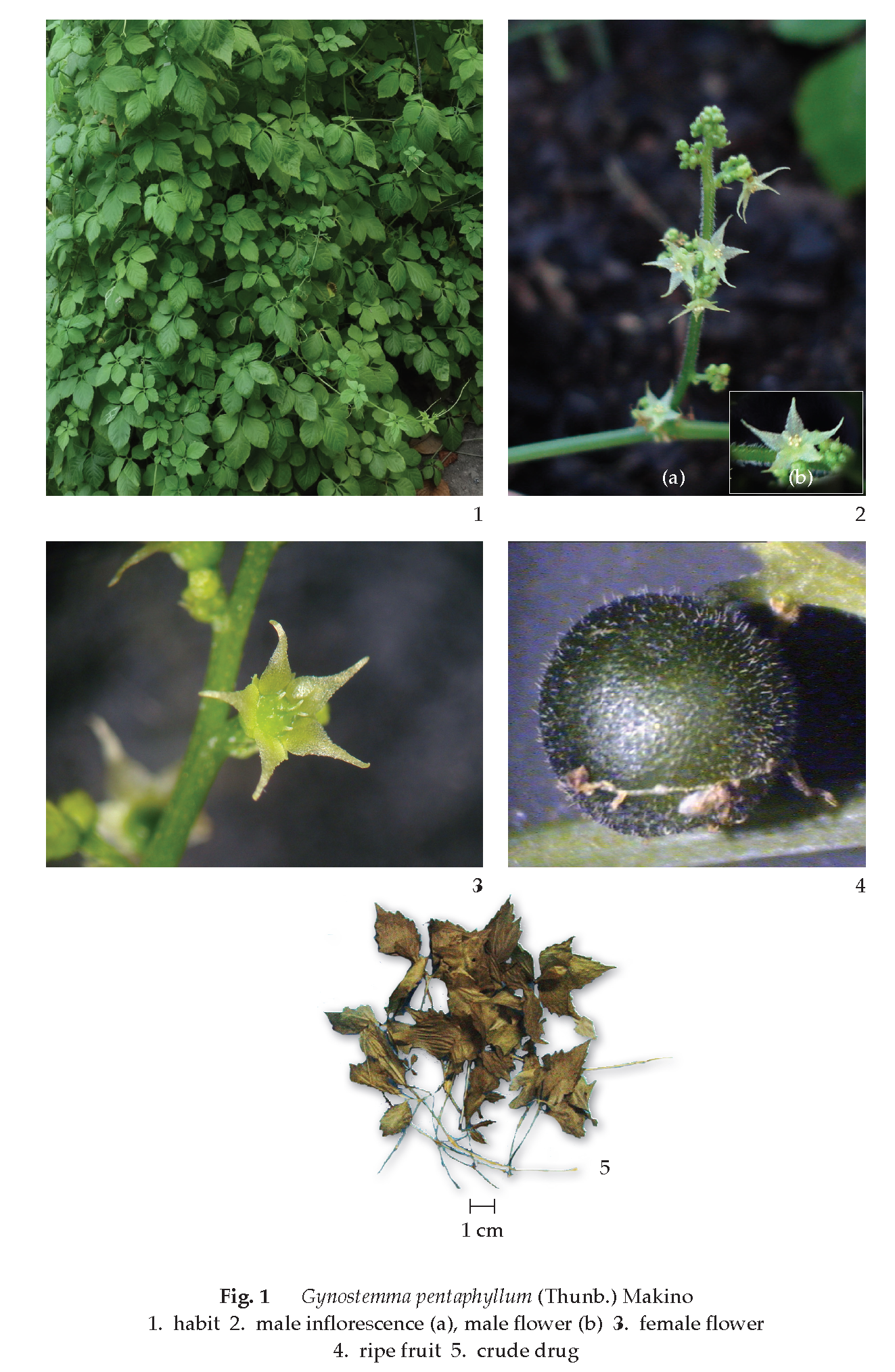
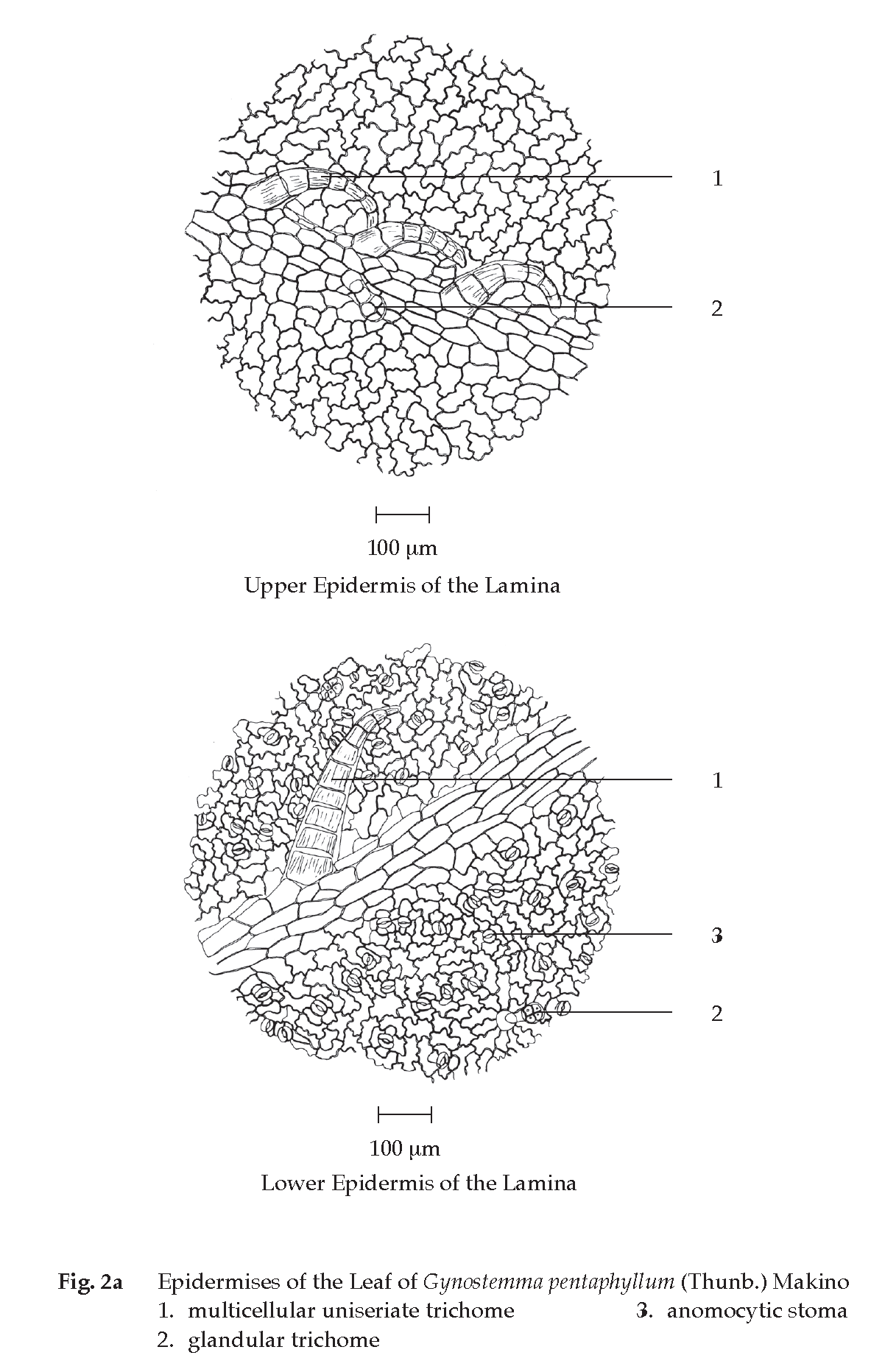
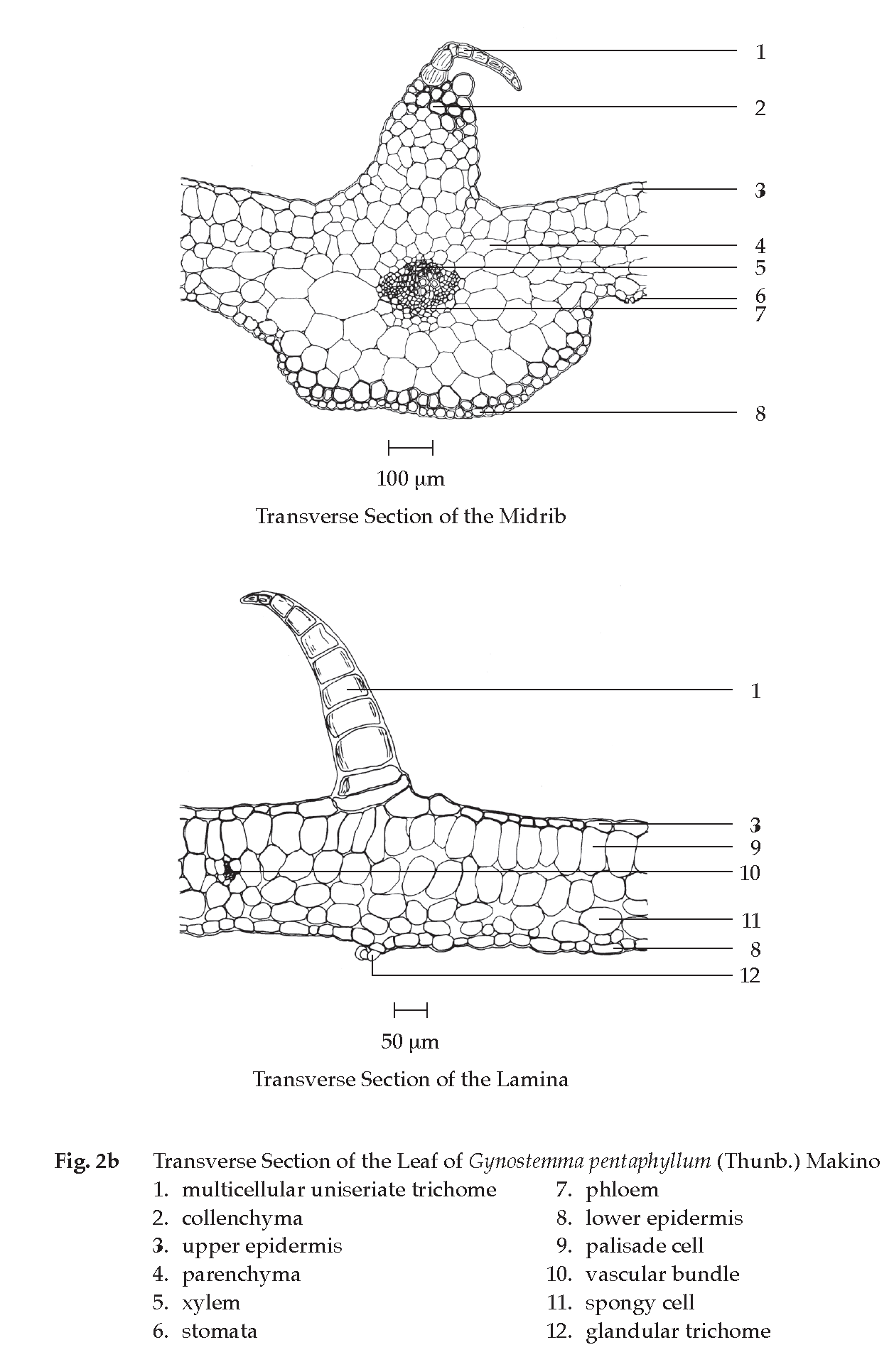
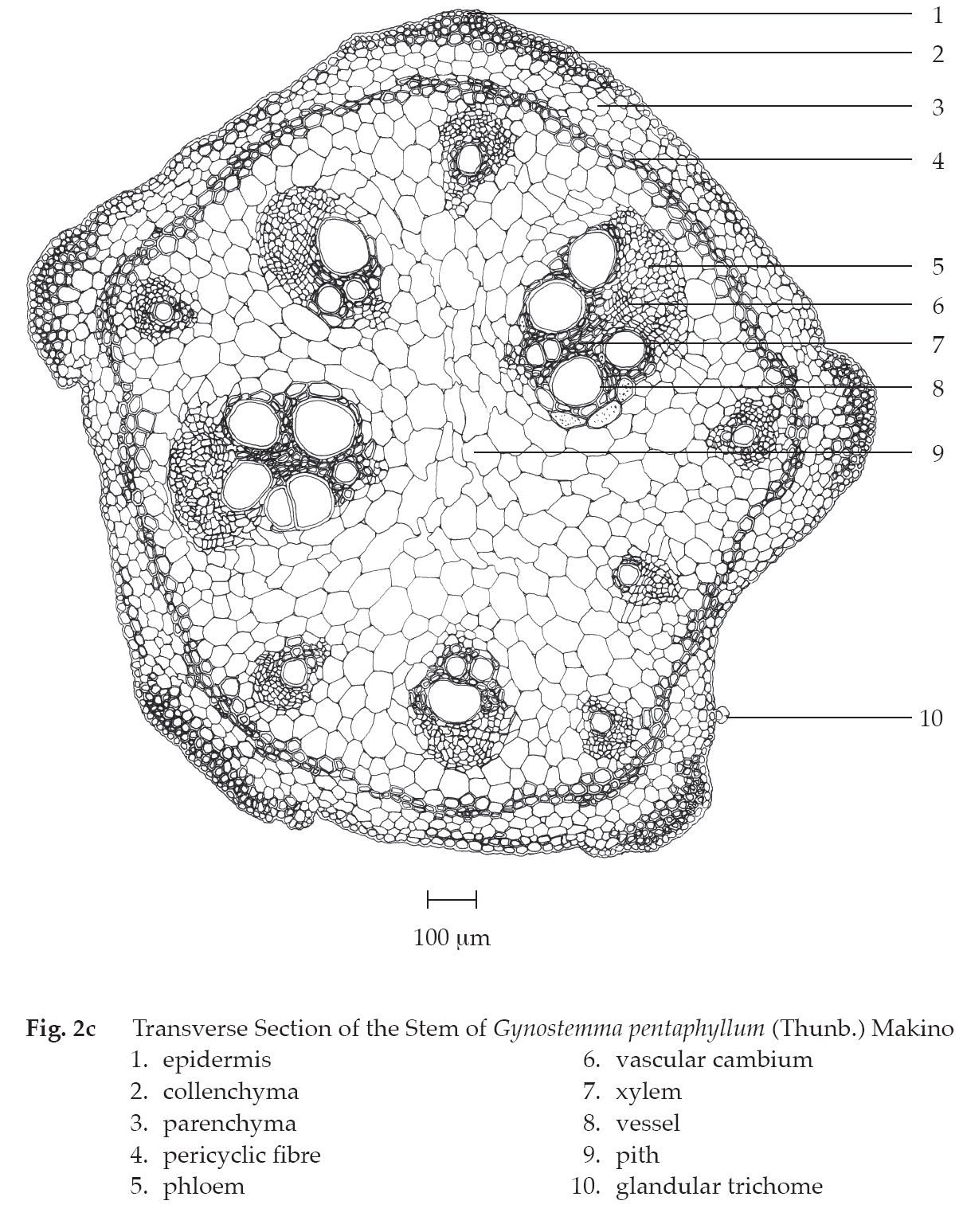
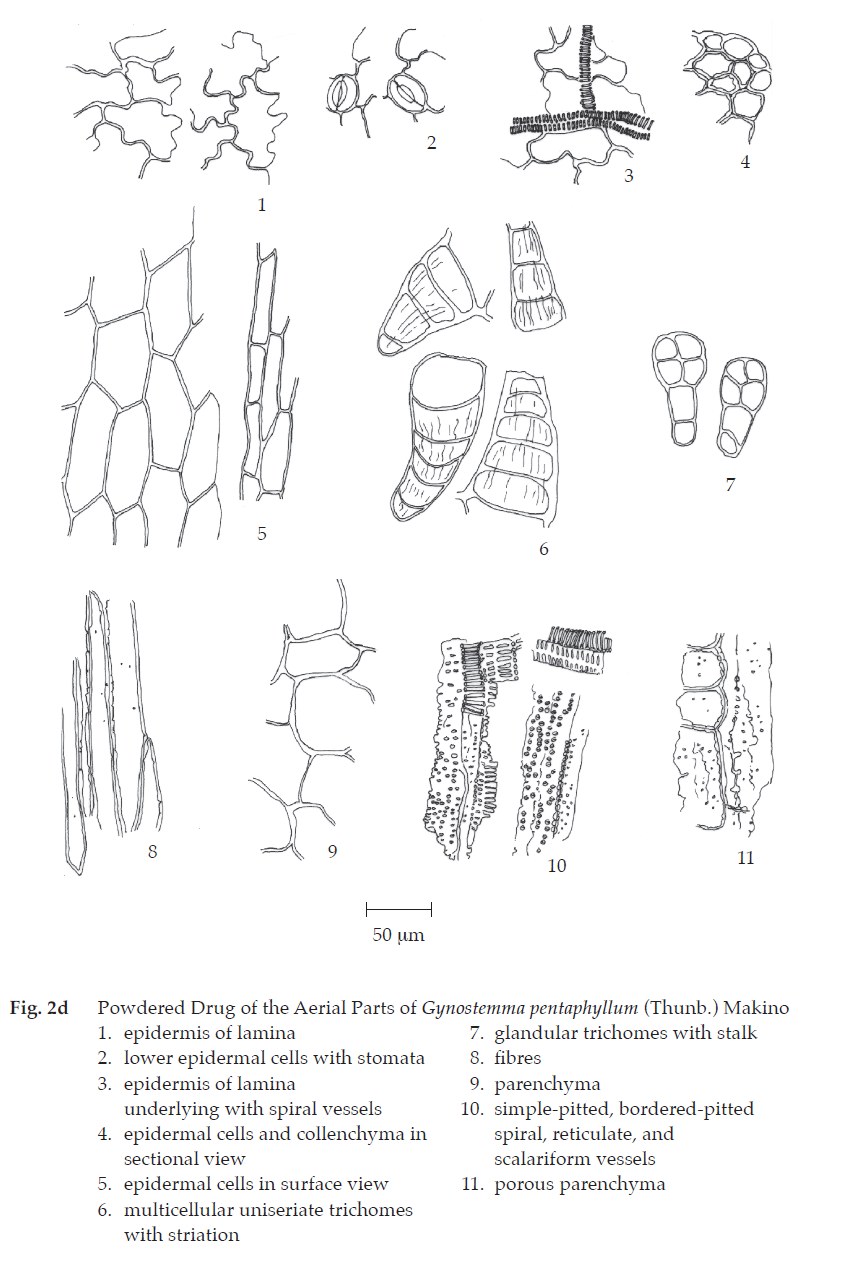
Five-Leaf Gingseng in powder possesses the diagnostic microscopical characters of the unground drug. Glandular trichomes with stalk and multicellular uniseriate trichomes with cuticularized striation are characteristic.
Packaging and storage Five-Leaf Gingseng shall be kept in well-closed containers, protected from light, and stored in a dry place.
Identification
A. Reflux 1 g of the sample, in fine powder, with 50 mL of water on a water-bath for 30 minutes and filter (solution 1). Transfer 10 mL of solution 1 to a separator and extract with the equal volume of 1-butanol. To the 1-butanol extract, add 100 mg of decolorizing charcoal, swirl for a few minutes and filter. Evaporate 2 mL of the filtrate to dryness and add a few drops of sulfuric acid: a red colour is produced.
B. Transfer 1 mL of solution 1 to a stoppered test-tube and shake for about 15 seconds: a persistent foam is produced for over 30 minutes.
C. Carry out the test as described in the “Thin-Layer Chromatography” (Appendix 3.1), using silica gel G as the coating substance and a lower layer of a mixture of 65 volumes of chloroform, 35 volumes of methanol and 10 volumes of water as the mobile phase and allowing the solvent front to ascend 12 cm above the line of application. Apply separately to the plate, 10 μL each of the following two solutions. Prepare solution (A) by transferring 10 mL of solution 1 and extracting with two 10-mL portions of 1-butanol. Combine the 1-butanol extracts and evaporate to dryness under reduced pressure. Dissolve the residue in 1 mL of methanol. For solution (B), dissolve 1 mg of gypenoside III in 1 mL of methanol. After removal of the plate, allow it to dry in air. Spray the plate with a 20 per cent v/v solution of sulfuric acid in methanol and heat at 105° for 5 minutes. The chromatogram obtained from solution (A) shows a violet spot (hRf value 26 to 27), corresponding to the gypenoside III spot obtained from solution (B). Several spots of different colours appear (Table 1); see also Fig.3.

Loss on drying Not more than 8.0 per cent w/w after drying 5 g at 105° to constant weight (Appendix 4.15).
Foreign matter Not more than 2.0 per cent w/w (Appendix 7.2).
Acid-insoluble ash Not more than 2.0 per cent w/w (Appendix 7.6).
Total ash Not more than 14.0 per cent w/w (Appendix 7.7).
Water-soluble extractive Not less than 20.0 per cent w/w (Appendix 7.12).
Content of total crude saponins Not less than 8.0 per cent w/w when determined by the following method.
Place about 500 mg of Five-Leaf Gingseng, in fine powder, accurately weighed, in a 250-mL round-bottomed flask, reflux with 50 mL of water for 2 hours and filter. Wash the marc with two 20-mL portions of hot water. Combine the washings and the filtrate, transfer to a 100-mL volumetric flask and adjust to volume. Transfer 20.0 mL of this solution to a separator and extract with three 10-mL portions of 1-butanol. Combine the 1-butanol extracts, wash with two 10-mL portions of water and discard the washings. Evaporate the combined 1-butanol extract to dryness and dry the residue at 105° to constant weight. Weigh the residue and calculate the content of total crude saponins on the dried basis.
